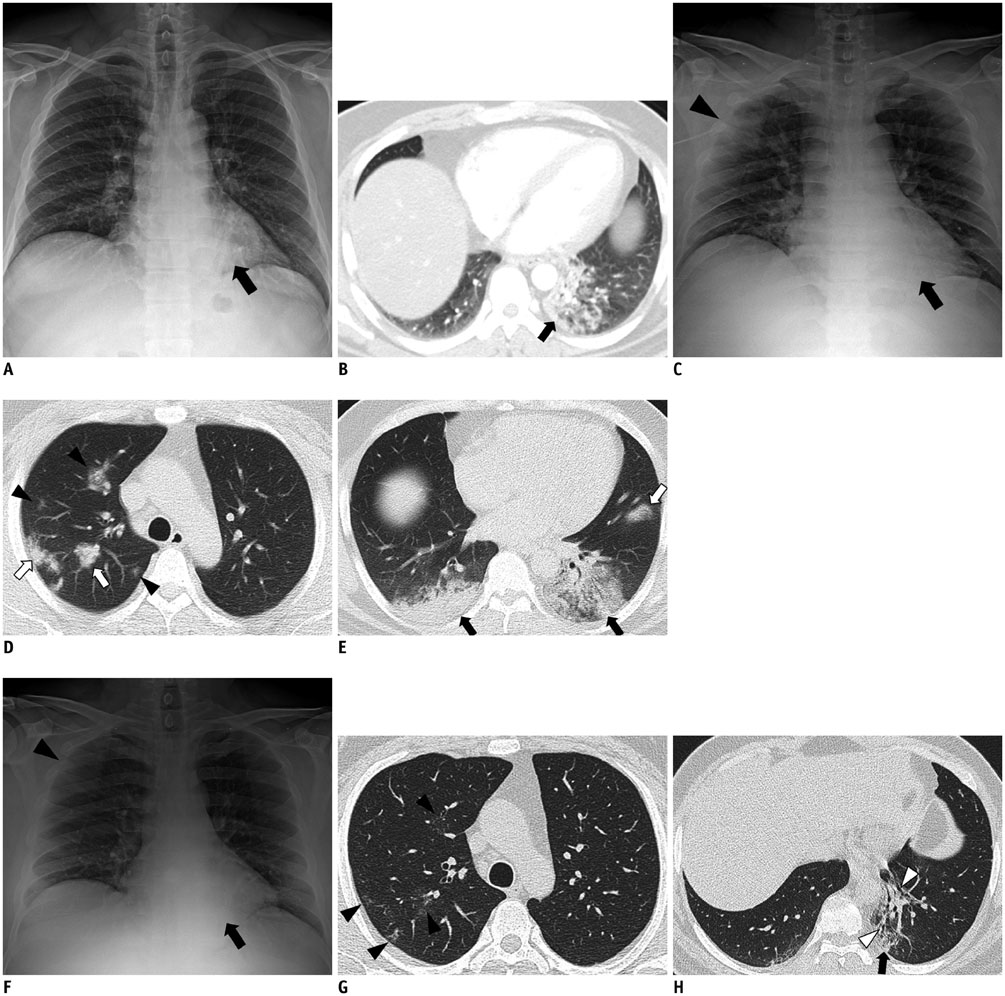Middle East Respiratory Syndrome-Coronavirus Infection: A Case Report of Serial Computed Tomographic Findings in a Young Male Patient
- Affiliations
-
- 1Department of Radiology, Dong-A University Hospital, Busan 49201, Korea. gnlee@dau.ac.kr
- 2Division of Infectious Diseases, Department of Internal Medicine, Dong-A University Hospital, Busan 49201, Korea.
- KMID: 2351177
- DOI: http://doi.org/10.3348/kjr.2016.17.1.166
Abstract
- Radiologic findings of Middle East respiratory syndrome (MERS), a novel coronavirus infection, have been rarely reported. We report a 30-year-old male presented with fever, abdominal pain, and diarrhea, who was diagnosed with MERS. A chest computed tomographic scan revealed rapidly developed multifocal nodular consolidations with ground-glass opacity halo and mixed consolidation, mainly in the dependent and peripheral areas. After treatment, follow-up imaging showed that these abnormalities markedly decreased but fibrotic changes developed.
MeSH Terms
Figure
Cited by 4 articles
-
Pneumonia Associated with 2019 Novel Coronavirus: Can Computed Tomographic Findings Help Predict the Prognosis of the Disease?
Kyung Soo Lee
Korean J Radiol. 2020;21(3):257-258. doi: 10.3348/kjr.2020.0096.Novel Coronavirus Pneumonia Outbreak in 2019: Computed Tomographic Findings in Two Cases
Xiaoqi Lin, Zhenyu Gong, Zuke Xiao, Jingliang Xiong, Bing Fan, Jiaqi Liu
Korean J Radiol. 2020;21(3):365-368. doi: 10.3348/kjr.2020.0078.Chest Radiographic and CT Findings of the 2019 Novel Coronavirus Disease (COVID-19): Analysis of Nine Patients Treated in Korea
Soon Ho Yoon, Kyung Hee Lee, Jin Yong Kim, Young Kyung Lee, Hongseok Ko, Ki Hwan Kim, Chang Min Park, Yun-Hyeon Kim
Korean J Radiol. 2020;21(4):494-500. doi: 10.3348/kjr.2020.0132.Novel respiratory infectious diseases in Korea
Hyun Jung Kim
Yeungnam Univ J Med. 2020;37(4):286-295. doi: 10.12701/yujm.2020.00633.
Reference
-
1. Zaki AM, van Boheemen S, Bestebroer TM, Osterhaus AD, Fouchier RA. Isolation of a novel coronavirus from a man with pneumonia in Saudi Arabia. N Engl J Med. 2012; 367:1814–1820.2. Ajlan AM, Ahyad RA, Jamjoom LG, Alharthy A, Madani TA. Middle East respiratory syndrome coronavirus (MERS-CoV) infection: chest CT findings. AJR Am J Roentgenol. 2014; 203:782–787.3. Das KM, Lee EY, Enani MA, AlJawder SE, Singh R, Bashir S, et al. CT correlation with outcomes in 15 patients with acute Middle East respiratory syndrome coronavirus. AJR Am J Roentgenol. 2015; 204:736–742.4. Corman VM, Eckerle I, Bleicker T, Zaki A, Landt O, Eschbach-Bludau M, et al. Detection of a novel human coronavirus by real-time reverse-transcription polymerase chain reaction. Euro Surveill. 2012; (17):pii: 20285.5. Alagaili AN, Briese T, Mishra N, Kapoor V, Sameroff SC, Burbelo PD, et al. Middle East respiratory syndrome coronavirus infection in dromedary camels in Saudi Arabia. Mbio. 2014; 5:e00884–e00814. DOI: 10.1128/mbio.00884-14.6. Centers for Disease Control and Prevention. Notice to health care providers: updated guidelines for evaluation of severe respiratory illness associated with Middle East respiratory syndrome coronavirus (MERS-CoV). Accessed June 22, 2015. http://emergency.cdc.gov/HAN/han00348.asp Published June 7, 2013.7. World Health Organization. MERS-CoV in the Republic of Korea at a glance. Accessed June 22, 2015. http://www.wpro.who.int/outbreaks_emergencies/wpro_coronavirus/en/ Published June 22, 2015.8. Assiri A, Al-Tawfiq JA, Al-Rabeeah AA, Al-Rabiah FA, Al-Hajjar S, Al-Barrak A, et al. Epidemiological, demographic, and clinical characteristics of 47 cases of Middle East respiratory syndrome coronavirus disease from Saudi Arabia: a descriptive study. Lancet Infect Dis. 2013; 13:752–761.9. Das KM, Lee EY, Jawder SE, Enani MA, Singh R, Skakni L, et al. Acute Middle East respiratory syndrome coronavirus: temporal lung changes observed on the chest radiographs of 55 patients. AJR Am J Roentgenol. 2015; 205:W267–W274.
- Full Text Links
- Actions
-
Cited
- CITED
-
- Close
- Share
- Similar articles
-
- An Unexpected Outbreak of Middle East Respiratory Syndrome Coronavirus Infection in the Republic of Korea, 2015
- The Korean Middle East Respiratory Syndrome Coronavirus Outbreak and Our Responsibility to the Global Scientific Community
- A Fatal Case of Middle East Respiratory Syndrome Corona Virus Infection in South Korea: Chest Radiography and CT Findings
- The Same Middle East Respiratory Syndrome-Coronavirus (MERS-CoV) yet Different Outbreak Patterns and Public Health Impacts on the Far East Expert Opinion from the Rapid Response Team of the Republic of Korea
- Middle East Respiratory Syndrome Coronavirus Infection in Children


